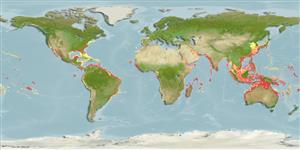Common names from other countries
>
Tetraodontiformes (Puffers and filefishes) >
Monacanthidae (Filefishes)
Etymology: Aluterus: Name from Greek meaning not free or detached, referring to the pelvis that does not form a spiny project (as it does in triggerfish) (R. Chandler, pers. Comm. 10/2014)..
Environment: milieu / climate zone / depth range / distribution range
Ecologia
marinhas associadas(os) a recifes; intervalo de profundidade 3 - 120 m (Ref. 36484), usually 3 - 20 m (Ref. 40849). Subtropical; 46°N - 30°S, 180°W - 180°E
Circumtropical.
Tamanho / Peso / Idade
Maturity: Lm ? range ? - ? cm
Max length : 110 cm TL macho/indeterminado; (Ref. 9710); common length : 55.0 cm TL macho/indeterminado; (Ref. 5450); peso máx. Publicado: 2.5 kg (Ref. 26340)
Espinhos dorsais (total) : 2; Raios dorsais moles (total) : 43 - 50; Espinhos anais: 0; Raios anais moles: 46 - 52. Snout concave (Ref. 1602); olive brown to grey in color, juveniles may be yellowish brown with dark spots (Ref. 4421). Elongate, strongly compressed filefish; tan with blue lines and spots. Caudal fin rounded (Ref. 26938) and long (Ref. 13442). Gill opening oblique, pelvic terminus rudimentary or absent; body and head with scattered small black spots (Ref. 13442).
Inhabit lagoon and seaward reefs (Ref. 9710). Occasionally are seen under floating objects (Ref. 1602). Juveniles may travel with weed rafts in open ocean for a long time and reaching a large size. Adults are usually seen along deep coastal slopes or outer reef drop-offs in about 20 meters depth (Ref. 48637). Benthopelagic (Ref. 58302). Feed on algae, seagrass, hydrozoans, gorgonians, colonial anemones, and tunicates. Caught at the surface using a hand net (Ref. 26165).
Life cycle and mating behavior
Maturities | Reprodução | Spawnings | Egg(s) | Fecundities | Larvas
Hutchins, J.B., 1986. Monacanthidae. p. 882-887. In M.M. Smith and P.C. Heemstra (eds.) Smiths' sea fishes. Springer-Verlag, Berlin. (Ref. 4421)
Categoria na Lista Vermelha da IUCN (Ref. 130435)
CITES (Ref. 128078)
Not Evaluated
Ameaça para o homem
Reports of ciguatera poisoning (Ref. 4690)
Utilização humana
Pescarias: espécies comerciais; peixe desportivo: sim; Aquário: Espécies comerciais
Ferramentas
Relatórios especiais
Descarregue XML
Fontes da internet
Estimates based on models
Preferred temperature (Ref.
115969): 22.6 - 29, mean 27.4 (based on 1766 cells).
Phylogenetic diversity index (Ref.
82804): PD
50 = 0.5625 [Uniqueness, from 0.5 = low to 2.0 = high].
Bayesian length-weight: a=0.01995 (0.00943 - 0.04220), b=2.93 (2.75 - 3.11), in cm Total Length, based on LWR estimates for this (Sub)family-body shape (Ref.
93245).
Nível Trófico (Ref.
69278): 2.8 ±0.4 se; based on diet studies.
Resiliência (Ref.
120179): Médio, tempo mínimo de duplicação da população 1,4 - 4,4 anos (Assuming tm=3-4).
Fishing Vulnerability (Ref.
59153): High to very high vulnerability (66 of 100).
